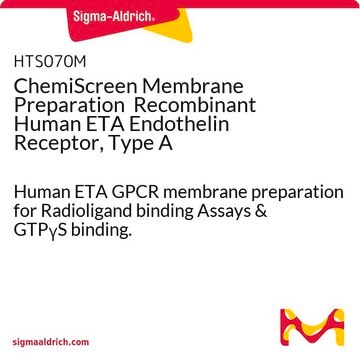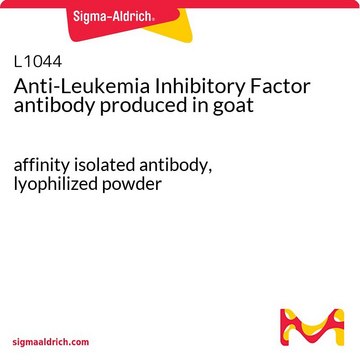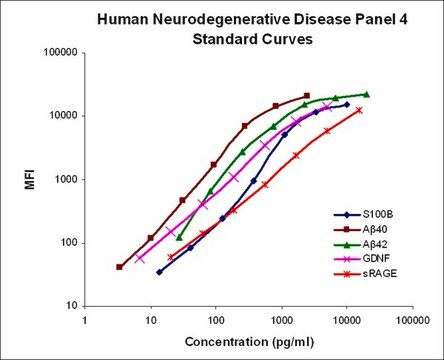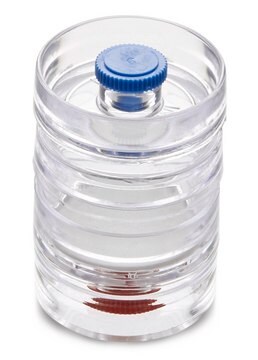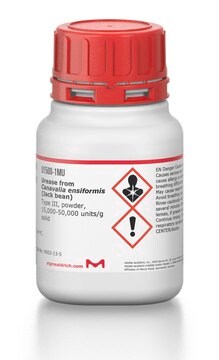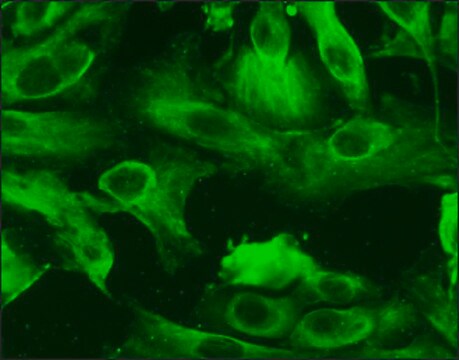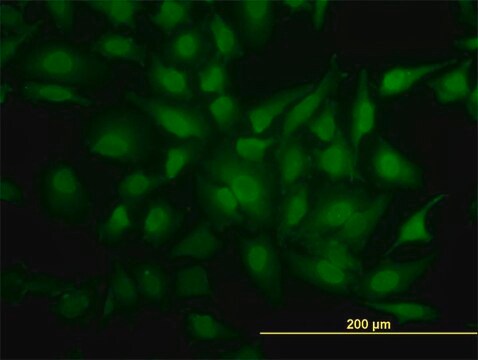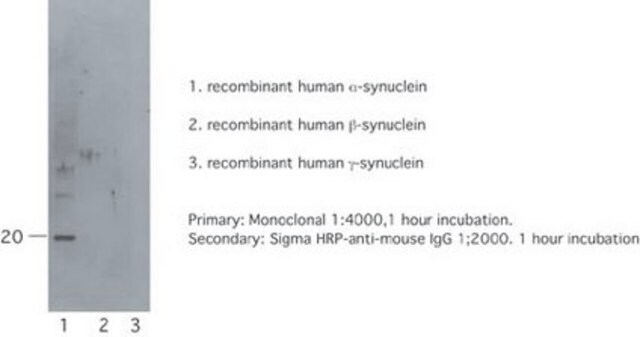HTS139M
ChemiSCREEN Preparat błonowy Rekombinowany ludzki receptor somatostatyny sst5
Human sst5 GPCR membrane preparation for Radioligand binding Assays & GTPγS binding.
Zaloguj sięWyświetlanie cen organizacyjnych i kontraktowych
About This Item
Kod UNSPSC:
41106514
eCl@ss:
32161000
NACRES:
NA.84
Polecane produkty
pochodzenie biologiczne
human
Poziom jakości
rekombinowane
expressed in Chem-1 cells
producent / nazwa handlowa
ChemiScreen
Chemicon®
metody
ligand binding assay: suitable (GTPγS)
radioligand binding assay (RLBA): suitable
numer dostępu NCBI
numer dostępu UniProt
Warunki transportu
dry ice
Opis ogólny
Pełnej długości ludzki cDNA kodujący SSTR5
Somatostatyna (sst) jest wielofunkcyjnym peptydem o dwóch biologicznie aktywnych formach, sst-14 i sst-28, które są syntetyzowane w neuronach w mózgu, a także w tkankach obwodowych, takich jak trzustka i jelita (Gillies, 1997). SST wywiera zróżnicowany wachlarz efektów, które obejmują hamowanie wydzielania hormonalnego, modulację neurotransmisji i regulację proliferacji komórek poprzez stymulację rodziny pięciu receptorów sprzężonych z białkiem G. Receptor somatostatyny sst5 jest hamującym receptorem sprzężonym z białkiem G, który wywiera silne działanie cytostatyczne na różne typy komórek. U myszy sst5 pośredniczy w hamowaniu przez somatostatynę wydzielania insuliny przez trzustkę i przyczynia się do regulacji homeostazy glukozy i wrażliwości na insulinę (Strowski i wsp. 2003). Ponadto niedobór sst5 prowadzi do selektywnych płciowo dymorficznych zmian w ekspresji zarówno somatostatyny mózgowej, jak i trzustkowej (Ramirez i in. 2004). Preparaty błonowe sst5 firmy Millipore są surowymi preparatami błonowymi wykonanymi z naszych zastrzeżonych stabilnych rekombinowanych linii komórkowych w celu zapewnienia wysokiego poziomu ekspresji powierzchniowej GPCR; dzięki temu są idealnymi narzędziami HTS do badań przesiewowych agonistów i antagonistów sst5. Preparaty błonowe wykazują Kd 1,2 nM dla[125I]-Somatostatyny 14. Przy 0,5 nM[125I]-Somatostatyny 14, preparat membranowy sst5 o objętości 5 μg/dołek zazwyczaj daje ponad 10-krotny stosunek sygnału do tła.
Zastosowanie
Preparat błonowy ludzkiego sst5 GPCR do testów wiązania radioligandów i wiązania GTPγS.
Test wiązania radioligandu i wiązanie GTPγS.
Działania biochem./fizjol.
GPCR Class: A
Protein Target: sst5
Target Sub-Family: Somatostatin
Jakość
Table 1. Signal:background and specific binding values obtained in a competition binding assay with varying amounts of sst5 Receptor membrane prep.
SPECIFICATIONS: 1 unit = 5 µg membrane preparation
Bmax for [125I]-Somatostatin binding: 10.4 pmol/mg protein
Kd for [125I]-Somatostatin binding: ~1.2 nM
| 10 µg/well | 5 µg/well | |
|---|---|---|
| Signal:Background | 15.2 | 15.7 |
| Specific Binding (cpm) | 25710 | 21425 |
SPECIFICATIONS: 1 unit = 5 µg membrane preparation
Bmax for [125I]-Somatostatin binding: 10.4 pmol/mg protein
Kd for [125I]-Somatostatin binding: ~1.2 nM
Charakterystyka techniczna
Warunki inkubacji
ZALECANE WARUNKI BADAŃ: Membrany miesza się z radioaktywnym ligandem i nieznakowanym konkurentem (patrz rysunki 1 i 2 dla badanych stężeń) w buforze wiążącym w niewiążącej 96-dołkowej płytce i inkubuje przez 1-2 h. Przed filtracją 96-dołkowa płytka zbiorcza FC (Millipore nr kat. MAHF C1H) jest powlekana 0,33% polietylenoiminą przez 30 minut, a następnie przemywana 50 mM HEPES, pH 7,4, 0,5% BSA. Reakcja wiązania jest przenoszona na płytkę filtracyjną i płukana 3 razy (1 ml na studzienkę na płukanie) buforem płuczącym. Płytka jest suszona i liczona.
Bufor wiążący: 50 mM Hepes, pH 7,4, 5 mM MgCl2, 1 mM CaCl2, 0,2% BSA, filtrowany i przechowywany w temperaturze 4°C.
Radioligand:[125I]-Somatostatyna 14. (Perkin Elmer#:NEX-389 )
Bufor płuczący: 50 mM Hepes, pH 7,4, 500 mM NaCl, 0,1% BSA, filtrowany i przechowywany w temperaturze 4°C.
Jedno opakowanie zawiera membrany wystarczające na co najmniej 200 testów (jednostek), gdzie jednostka to ilość membrany, która da ponad 10-krotny stosunek sygnału do tła ze znakowaną 125Isomatostatyną 14 przy 0,5 nM.
ZALECANE WARUNKI BADAŃ: Membrany miesza się z radioaktywnym ligandem i nieznakowanym konkurentem (patrz rysunki 1 i 2 dla badanych stężeń) w buforze wiążącym w niewiążącej 96-dołkowej płytce i inkubuje przez 1-2 h. Przed filtracją 96-dołkowa płytka zbiorcza FC (Millipore nr kat. MAHF C1H) jest powlekana 0,33% polietylenoiminą przez 30 minut, a następnie przemywana 50 mM HEPES, pH 7,4, 0,5% BSA. Reakcja wiązania jest przenoszona na płytkę filtracyjną i płukana 3 razy (1 ml na studzienkę na płukanie) buforem płuczącym. Płytka jest suszona i liczona.
Bufor wiążący: 50 mM Hepes, pH 7,4, 5 mM MgCl2, 1 mM CaCl2, 0,2% BSA, filtrowany i przechowywany w temperaturze 4°C.
Radioligand:[125I]-Somatostatyna 14. (Perkin Elmer#:NEX-389 )
Bufor płuczący: 50 mM Hepes, pH 7,4, 500 mM NaCl, 0,1% BSA, filtrowany i przechowywany w temperaturze 4°C.
Jedno opakowanie zawiera membrany wystarczające na co najmniej 200 testów (jednostek), gdzie jednostka to ilość membrany, która da ponad 10-krotny stosunek sygnału do tła ze znakowaną 125Isomatostatyną 14 przy 0,5 nM.
Postać fizyczna
Płyn w buforze opakowaniowym: 50 mM Tris pH 7,4, 10% glicerol i 1% BSA bez konserwantów.
Metoda pakowania: Białko membranowe dostosowano do 1 mg/ml w 1 ml buforu do pakowania, szybko zamrożono i przechowywano w temperaturze -80°C
Metoda pakowania: Białko membranowe dostosowano do 1 mg/ml w 1 ml buforu do pakowania, szybko zamrożono i przechowywano w temperaturze -80°C
Przechowywanie i stabilność
Przechowywać zamrożone w temperaturze -70°C przez okres do 2 lat. Nie zamrażać i nie rozmrażać.
Informacje prawne
CHEMICON is a registered trademark of Merck KGaA, Darmstadt, Germany
Oświadczenie o zrzeczeniu się odpowiedzialności
Unless otherwise stated in our catalog or other company documentation accompanying the product(s), our products are intended for research use only and are not to be used for any other purpose, which includes but is not limited to, unauthorized commercial uses, in vitro diagnostic uses, ex vivo or in vivo therapeutic uses or any type of consumption or application to humans or animals.
Ta strona może zawierać tekst przetłumaczony maszynowo.
Kod klasy składowania
10 - Combustible liquids
Klasa zagrożenia wodnego (WGK)
WGK 2
Certyfikaty analizy (CoA)
Poszukaj Certyfikaty analizy (CoA), wpisując numer partii/serii produktów. Numery serii i partii można znaleźć na etykiecie produktu po słowach „seria” lub „partia”.
Masz już ten produkt?
Dokumenty związane z niedawno zakupionymi produktami zostały zamieszczone w Bibliotece dokumentów.
Nasz zespół naukowców ma doświadczenie we wszystkich obszarach badań, w tym w naukach przyrodniczych, materiałoznawstwie, syntezie chemicznej, chromatografii, analityce i wielu innych dziedzinach.
Skontaktuj się z zespołem ds. pomocy technicznej